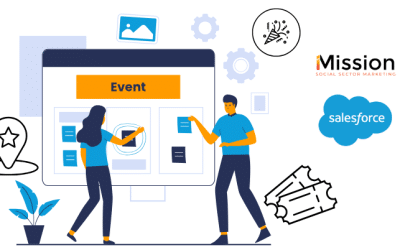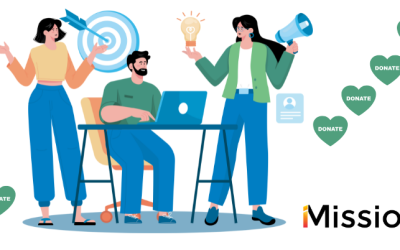Sadly, we don’t need to imagine natural disasters as they are all too real in our warming climate. Case in point, the West Coast is suffering through a series of the worst wildfires in history. Images of burned-out communities are in the media. Interviews of families who have lost everything are broadcast everywhere. What do nonprofits do? We step in and help.
Imagine a nonprofit that provides housing and financial assistance to people displaced by environmental disasters is scrambling to find the resources to help those impacted by the latest waves of fires. If there is any good news, it’s that there are people across the country looking for ways to help the communities and families affected.
The nonprofit’s development team sets up its own Facebook fundraising campaign to address the crisis. They engage their followers and friends to participate. Long-time, reliable donors quickly give. Through their Facebook accounts, younger donors also take action by inviting their friends and family to participate. In a few days, the nonprofit has raised more with its Facebook fundraiser than it had raised online in all of the previous year.
But one morning, the staff discovers that the money raised is not only continuing to roll in. It’s now spiking up! What’s happening?

The Power of Social Networks
What the development team discovered is that their outreach efforts had gone viral. “Viral” fundraising happens when the friends of friends take action and start their own fundraisers. In turn, the friends of friends inspire others to take action. The energy transmits out across the social networks, and support from what appears to be random places flows in.
This is the power of social networks, and Facebook remains the largest online social network on the planet.
Moreover, Facebook makes it easy for people to give without having to leave Facebook. Once the donation button is added to your Facebook page, your supporters give with just a few clicks. Facebook automatically adds the person’s name and payment information from the Facebook user’s account. Facebook charges zero fees on its Fundraising Pages, and the money raised is paid straight to the charity’s bank account.
Nonprofits have received billions of dollars from Facebook’s fundraisers. Beyond the impressive dollar amounts, these fundraisers are delivering new donors – a large percentage of those who donate through social media are new to the organization.
If you are thinking that “crisis” fundraising that might go viral is not something that you can budget for, then you’re right. In fact, fundraisers going viral are the exception to the rule. But rest assured, nonprofits are using Facebook fundraising for planned events and everyday fundraising. Success revolves around getting organized around five basic elements:
- Enhance Your Facebook Presence
- Learn the Updated Facebook Fundraising Features
- Plan for The Different Fundraising Opportunities
- Give Your Supporters the Tools They Need to Run Their Own Fundraisers
- Establish the Follow-Up Process
1. Enhance Your Facebook Presence
Think of your Facebook page as the front cover of your Facebook fundraising effort. Your organization likely has a page. The page may have been created years ago. Many things likely have changed for your nonprofit. Your first steps toward successful nonprofit fundraising will be taking a fresh look at your Facebook page.
Start by looking at your page with a pair of fresh eyes.
- Does it convey your organization’s impact and credibility?
- Is your mission statement clear?
- Is the contact information correct?
- Is your branding consistent?
2. Learn the Updated Facebook Fundraising Features
While your nonprofit has been evolving, Facebook also has been enhancing its fundraising. Facebook offers a step-by-step guide for setting up its suite of tools available to support your nonprofit’s fundraising. Included in the guide are:
- How to set up a Facebook Nonprofit Page Fundraiser
- Setting up the Facebook Donate Button which gives supporters an easy way to give using the information —- including credit card information — that already is held by Facebook.
- Engagement with Facebook Live. Video content gets much higher levels of engagement on Facebook. The live stream can include a donate button or link to your Nonprofit Page Fundraiser from your Facebook live video to raise money for your cause in real-time.
3. Plan for the Different Facebook Fundraising Opportunities
Your nonprofit and its supporters can use Facebook fundraising in different ways. Think about Facebook fundraising in two ways: Your nonprofit can run the fundraiser, or the fundraiser can be created and driven independently by new or long-standing supporters.
Nonprofit-run Facebook Fundraisers
An example of a nonprofit running a Facebook fundraiser focusing on its Giving Tuesday efforts. Facebook may provide limited gift matching for Giving Tuesday fundraisers. As a late November event, the Giving Tuesday event on Facebook also can be strategically coupled with a year-end giving appeal.
Another example would be to have a Facebook fundraiser ready for when a topic or issue that your nonprofit addresses become a hot topic in the media. Examples include national disasters, international conflicts, or when issues of homelessness, hunger, or racial disparity come into focus. At these moments, people want to find a way to extend their financial support to the work your nonprofit is doing. By getting your campaign launched quickly, your nonprofit may be the beneficiary of this desire to help.
Supporter-run Facebook Fundraisers
Almost anybody with a Facebook account can set up a fundraising event on their personal page. They just need to log into their account and click over to the general fundraising page. On this page, they’ll be able to search for your 501(c)(3) nonprofit and set up a fundraiser on your behalf.
Your nonprofit simply need to encourage them to take action. Urge people to create their own fundraisers on Facebook. Use email, events, and messaging apps to promote.
Occasion Fundraisers
Occasion fundraisers can provide the reasons for people to take action. These can be personally compelling life moments for your supporters to reach out to their networks. Events include birthdays, anniversaries, weddings, and memorials. Birthday fundraisers, in fact, have become popular. This may be driven by reminders Facebook sends two weeks before birthdays encouraging a fundraiser.
Consider reaching out to your existing supporters several times a year telling them how much you’d appreciate them keeping your organization in mind on their special occasions. For the people in your supporters’ networks, donating to an organization they care about on a special occasion is at least as much about honoring their friend or family member as it is about contributing to your cause.
Facebook Fundraising Challenges
Things get a bit more complicated, but possibly a whole lot more fun with Facebook Challenges.
A Facebook challenge is a virtual fundraising event that uses multiple features within Facebook to sign up participants and move them into an online group.
Participants commit to completing certain goals, like running, walking, or even losing weight. Participants ask their networks to support their activity through donations, often setting a specific goal amount.
Participants do the challenge activity in their own time; they can fit it into their busy lives. Participants also can encourage and motivate each other to do the challenge every day and to fundraise.
Everything happens in the Facebook ecosystem. Facebook challenges can see much higher activation and conversion rates than other platforms. Participants don’t have to set up new accounts or try to understand an unfamiliar system.
4. Give Your Supporters the Tools They Need to Run Their Own Facebook Fundraiser
You may have a lot of experience running Facebook Fundraisers, but your supporters might not, and some could find it intimidating. You can help by walking them through the tools they need and providing good examples of successful supporter fundraisers.
Consider putting together a guide on Facebook Fundraisers for your specific organization that you can share with your supporters. Start with the basics by pointing them to the “Raise Money” tab on your organization’s Facebook Fundraising page, and walk them through the questions they’ll have to answer about the name and duration of the fundraiser, including their total amount goal. Examples of what you can include in your guide include:
Encourage Sharing Meaningful Stories
Most importantly, Facebook asks supporters to include a story about why they’re raising money for your cause. The more personal and specific the story, the more likely their friends and family will be moved to support them by donating.
Say a supporter is raising funds for an organization that helps settle asylum seekers and shares her own story and photos about being the grandchild of asylum seekers herself. A supporter’s own circle of friends and family can be deeply moved, motivating them to donate.
Promoting Facebook Fundraisers
Once a supporter has created a fundraiser, there are three main things she needs to do to give it its best shot. She can use the “Get Started” button, which will bring up a list of Facebook contacts so she can invite friends and family.
She can share it in her newsfeed by creating a post about the fundraiser, which should already include her specific story about her connection to the cause.
Sharing the post as “public” will get it onto her timeline, however, the Facebook algorithm limits the number of people who see public posts. Sharing it with specific friends from a drop-down list lets her be sure that those friends will see the post.
Finally, your supporter can make the first donation to the fundraiser to get things started. The vast majority of fundraisers that don’t receive any donations within their first 24 hours perform poorly overall. Friends and family take their cues about donation amounts from the first donation, with most giving the same amount of the initial donation, or a bit less.
Invite Organizers and Consider Matching Options
Adding Organizers
Your supporters can add up to three people to act as organizers for their individual Facebook Fundraisers to help manage them and to rally more people to reach their fundraising goals. Each of these people will be listed as an organizer on the fundraiser page and will be able to edit the fundraiser and manage posts. Adding organizers can help expand the reach of your supporters’ individual fundraisers by tapping into the organizers’ own social networks. It can also help build a sense of community by having several people work towards the same goal together.
The Motivating Power of the Match
Your supporters can match donations from family and friends for their Facebook Fundraiser. Setting up a match can inspire more people to give, and can encourage each donor to give more. A supporter who runs a fundraiser for you can set the total amount she’s comfortable matching, and if the total amount of donations meets or exceeds the match at the end of the fundraiser, she will make the match donation automatically via Facebook charge. If the total raised doesn’t meet the matched amount, she is not charged anything.
Supporters can add a match to their fundraisers under the “More Options” tab on their fundraising page, entering the total amount they want to match there. For a match to be successful, people have to know it’s out there, so the matcher should post and share about it often during the length of her fundraiser. Once donations are made towards a match goal, it’s not possible to edit or delete the matching donation.
5. Establish the Follow-Up Process
Many of the donations that you will receive through Facebook will be from first-time donors. This is because Facebook fundraising offers nonprofits a powerful way to reach new people. It also makes it easy for them to donate.
Facebook also takes steps to protect the privacy of donors. Unless the donor opts in to allow Facebook to provide this information, you will not be able to get their contact information. This is a clear disadvantage compared to driving people to your website’s donation page.
Facebook provides ways to reach out to supporters without providing their contact information directly to you. By using On-Facebook Donation Ads, you will have the ability to target previous fundraiser creators and previous donors with ads. This is the most direct way for your organization to re-engage with previous fundraiser creators and donors. Yes, Facebook charges nonprofits for the privilege of connecting with these donors.
On the flip side, if your nonprofit has not budgeted some funds for social media advertising, it’s likely missing important opportunities to connect with the many people who care about what your nonprofit is doing but do not yet appreciate — or even know about – the organization.
To use these ads effectively, use them to promote the calls to action that will motivate potential donors to give you their contact information. These might include event registrations, direct donations, volunteer opportunities, and others.
Facebook Fundraising and Digital Engagement
Whether your nonprofit captures the donor contact information directly from the donation opt-in or from the Donation Ad, nonprofits need to have a process that builds relationships and brand following the giving event. These may include an automated email series found in most email marketing platforms.
Facebook fundraising offers nonprofits a powerful way to raise money that leverages the time and talents of the organization’s staff. It provides new and fun ways to engage and activate long-standing donors. All while offering effective ways to utilize the power of social networks to find new donors.
Looking for a way to kick-start your Facebook fundraising and your nonprofit’s broader pursuit of digital engagement and fundraising? Contact the iMission digital fundraising team.
If your organization uses Salesforce for fundraising, we can help. If you’re just starting out, or looking to step up your game, Mission can help you reach your goals.



